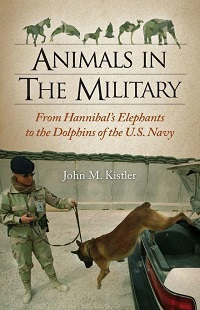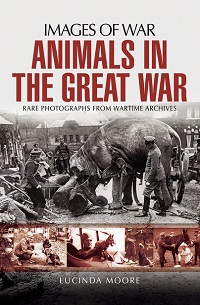How will these resources help you?
The part played by animals in the First World War offers an unusual perspective on warfare. Human soldiers were not the only creatures deployed on the battlefield. With their sharper senses and, in some cases, greater strength, animals including dogs, horses and mules carried out vital tasks during this terrible conflict. Dogs of all breeds were trained to deliver military orders and identify wounded soldiers. Horses and mules then transported the wounded to field hospitals. They also pulled heavy guns and carried supplies to the front lines. These resources show how human soldiers depended heavily on their animal comrades.
The full story

Animals in the Military: From Hannibal’s Elephants to the Dolphins of the U.S. Navy
by John M. Kistler, published by ABC-CLIO, (2011), 9781598843460
This book is a comprehensive history of the part animals played in war through the ages. Each chapter describes a single species and covers time periods in order, in three areas: animals in combat, animals in support and animals in experimental roles. The book covers the First World War in detail: horses and mules were particularly useful on the battlefields as the ground had been churned into mud and it was virtually impossible for soldiers to drag heavy loads; and in North Africa, specially trained camels carried wounded soldiers in canvas stretchers fixed to either side of their humps. Dogs were used more in this war than in any earlier war and played many essential roles. The book is fully illustrated with fascinating photographs.
The reality of animals in war

Animals in War
by Jilly Cooper, published by Corgi (Penguin), (1984), 9780552990912
In this book, Cooper pays tribute to the bravery of the animals that served alongside troops during wartime. Her stories begin with the First World War, and the realities of warfare are sometimes hard to read. For example, many horses and mules had no shelters in the freezing temperatures on the battlefields and many were killed by mustard gas. The book also features comic encounters and uplifting accounts of bravery and the loyalty between animals and the soldiers who looked after them. Cooper's writing style is accessible for students to read on their own.
The story in pictures

Animals in the Great War: Early Photographs from Wartime Archives
by Lucinda Moore, published by Pen & Sword Military, (2017), 9781473862111
Pictures can often tell a richer, deeper and more vivid story than words. This is certainly true of this book. Moore draws on illustrated magazines, books and postcards of the period, as well as photographs from the incredible collection of archive images held by the Mary Evans Picture Library. The book is the perfect complement to written accounts of the First World War.
Further Materials
Animals in the First World War by Neil Storey, published by Shire Publications (Bloomsbury), (2014), 9780747813675
Find this book
Voices of the First World War: Animals in War, published by the Imperial War Museums, (2021)
Access this resource
Karen Wallace has written over 300 fiction and non-fiction books for children. Think of an Eel won the Times Education Award and the Kurt Maschler Award in the UK. It also won the Parents’ Choice Gold Award in the US. Her first novel Raspberries on the Yangtze was shortlisted for the Guardian Young Fiction Award.
Text © Karen Wallace, 2021.
Text © Karen Wallace, 2021.



